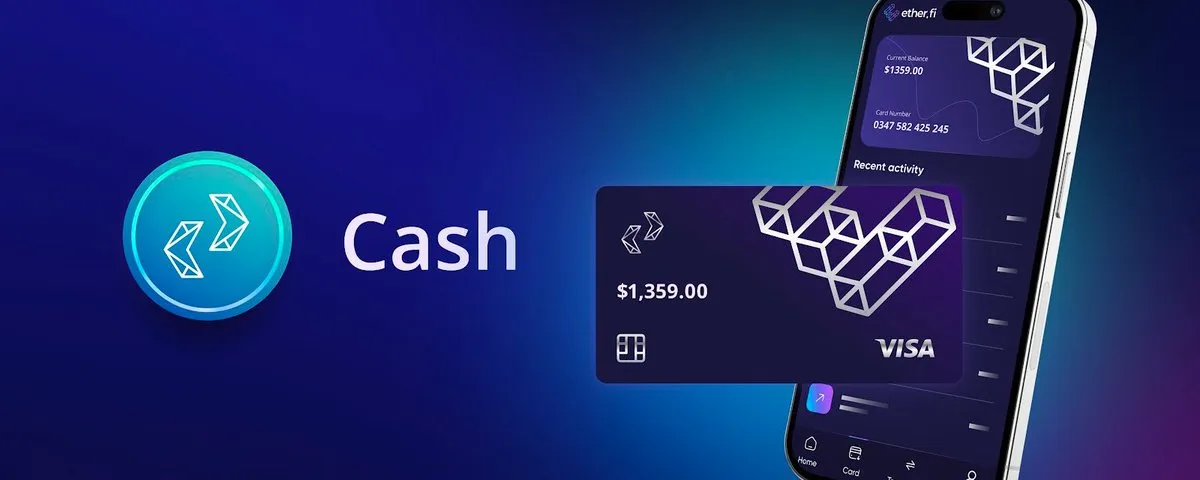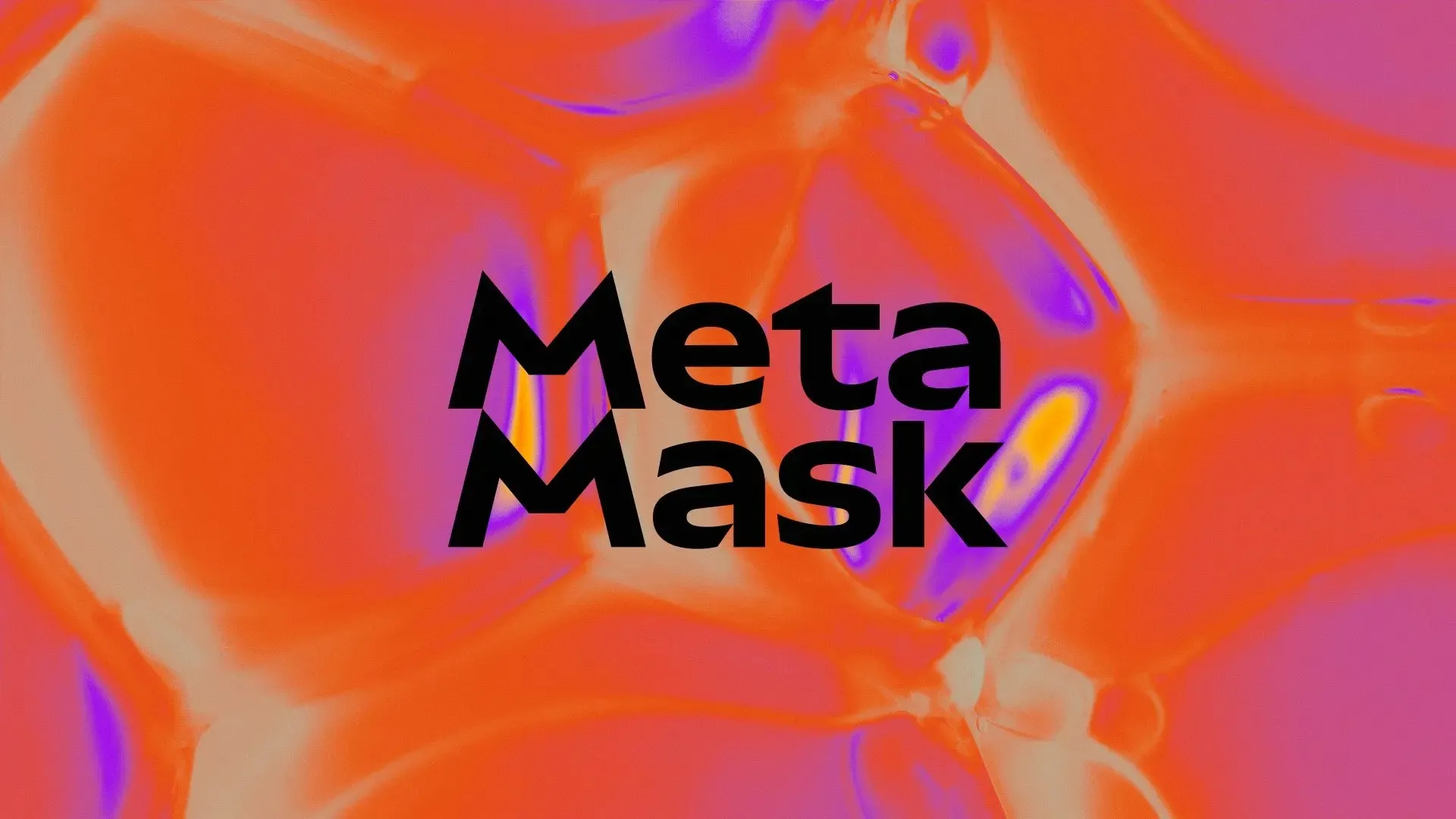x402 addresses the payment issue, while ERC-8004 addresses the trust issue. x402 took 5 months from release to explosion, and 8004 may be even faster.
Written by: David, Deep Tide TechFlow
x402 has clearly become popular.
CoinmarketCap data shows that the trading volume of various projects in the x402 ecosystem has surged 137 times, with the first ecosystem token PING skyrocketing from zero to a market value of 30 million dollars in just a few days.
Various KOLs have been intensively publishing analyses, covering everything from technical principles to project reviews; every angle you can think of has been explored.
However, two weeks ago, when we analyzed x402 early on and mentioned the potential of projects like PayAI, the entire market was relatively quiet.
In a rapidly shortening narrative and token lifecycle, researching new narratives in advance makes it easier to lock in opportunities for related assets.
Now, every time you refresh Twitter, a new "x402 ecosystem project" pops up; if you are just starting to research x402 now, to be frank, it might already be a bit late.
This doesn't mean the protocol itself lacks prospects, but rather that the most obvious Alpha opportunities have already been fully explored.
But while everyone is focused on x402, observant individuals will notice that another protocol has recently been frequently appearing in discussions within the English crypto community:
ERC-8004.
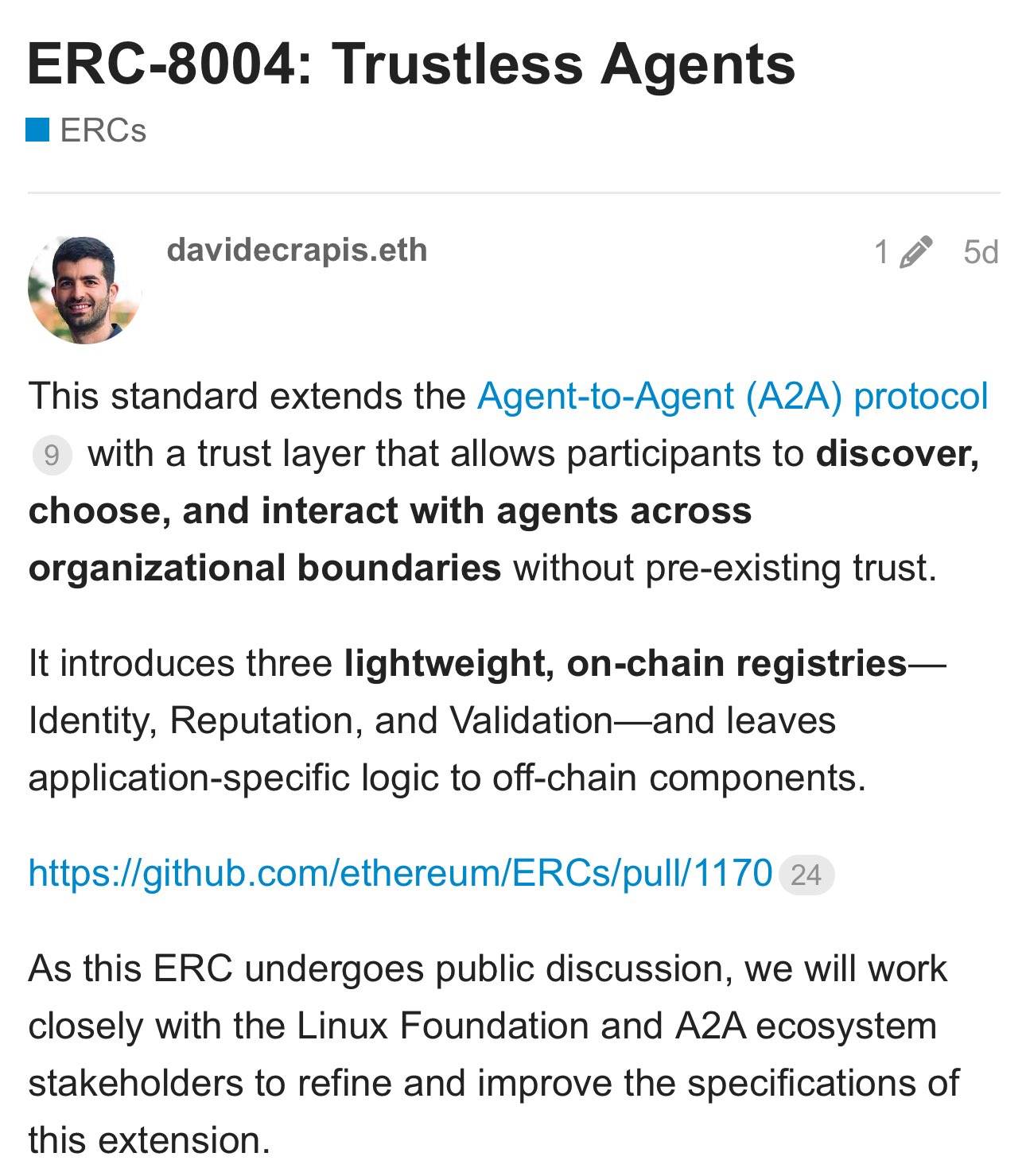
Interestingly, one of the proposers of ERC-8004, Davide Crapis, head of the dAI team at the Ethereum Foundation, revealed a detail in a September interview with Decrypt:
“ERC-8004 will support multiple payment methods, but having x402 extensions helps improve the developer experience.”
Wait, supporting multiple payment methods? Isn't x402 a payment protocol? Why does ERC-8004 also involve payments? Are they in competition or are they complementary?
At the beginning of October, when the Ethereum Foundation announced the final version of ERC-8004, the signatories included Marco De Rossi from MetaMask, Jordan Ellis from Google, and Erik Reppel from Coinbase, who is also the creator of x402.
The same person is simultaneously promoting two protocols. What logic is behind this?
If x402's explosion has shown everyone the huge market for AI Agent payments, then ERC-8004 may represent the other half of the puzzle that has yet to be fully recognized in this market.
While everyone is chasing the payment track, perhaps the real opportunity lies outside of payments.
ERC-8004: The prerequisite for payment is to register AI identities
To understand ERC-8004, we must first return to a fundamental question of the AI Agent economy.
Imagine a scenario where AI collaborates:
Your personal AI assistant needs to complete a complex task: preparing a market analysis report for your upcoming product launch.
This task exceeds its capabilities, so it needs to hire other specialized AIs: one for data scraping, one for competitive analysis, and one for chart creation.
Now with x402, payment is not an issue; a few lines of code can complete a USDC transfer; but before payment, your AI assistant faces a series of tricky identity issues:
Which of these self-proclaimed "professional data analysis AIs" are genuine, and which are frauds? What is their past work quality? How many clients have given positive reviews, and how many have complained?
It's a bit like doing business in a world without Taobao, without Dianping, and without business registration. Every transaction is a blind box, and every collaboration is a gamble.
Therefore, if we must explain it in one sentence, ERC-8004 is the "business registration + credit system + qualification certification center" for AI Agents in the on-chain world.
It gives each AI Agent an ID card, credit record, and capability certification, all recorded on the blockchain, accessible to anyone and tamper-proof.
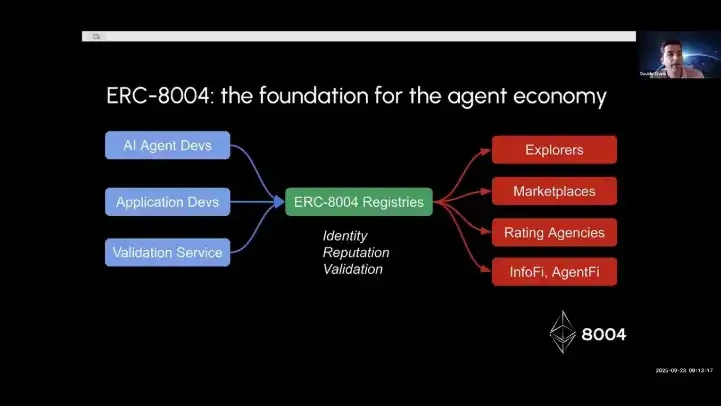
On August 13 of this year, Davide Crapis from the Ethereum Foundation, Marco De Rossi from MetaMask, and an independent AI developer Jordan Ellis jointly submitted the EIP-8004 proposal.
Interestingly, this Jordan Ellis was later confirmed to have close ties with Google's Agent-to-Agent team.

In simple terms, ERC 8004 adds a trust layer to Google's A2A. In the words of the Ethereum Foundation, this aims to establish a "trusted neutral track" for AI Agents.
Setting aside the complex code details, we can roughly see how 8004 works.
ERC-8004 is designed extremely simply, containing only three on-chain registries:
- Identity Registry: Each AI Agent receives an ERC-721 token as an ID card. Yes, you read that right, AI Agents are being NFT-ized. This means the Agent's identity can be viewed, transferred, and even traded in any wallet that supports NFTs.
This NFT points to a standardized "Agent card" that describes the Agent's name, skills, endpoints, and metadata. Because it follows open standards, any browser or marketplace can index it, enabling cross-platform permissionless discovery.
- Reputation Registry: This is the "Dianping" of the AI Agent world. Clients and other Agents can submit structured feedback, tagging by skills or tasks. More importantly, x402 payment proofs can be attached. Only clients who have actually paid can leave reviews, preventing fake reviews.
All reputation signals are public goods. This means anyone can build their own reputation scoring system based on this data.
- Validation Registry: For high-value tasks, just having reviews is not enough. The validation registry allows Agents to request third-party validation—this can be a TEE (Trusted Execution Environment) oracle, staking-backed reasoning, or zkML validation.

This is the qualification certification for the Agent world. An Agent claiming to be able to perform financial analysis can cryptographically prove that it has indeed run a specific model and produced specific results.
If this sounds a bit technical, let's look at a specific example.
Suppose an exchange's AI Agent needs a weekly DeFi market analysis report, but it lacks this capability.
Search Service: The client Agent finds analyst Agent Alice through the identity registry and views the service description on her NFT identity card.
Check Reputation: It finds that Alice has 156 positive reviews, an 89% completion rate, and real reviews with x402 payment proofs.
Escrow Payment: It pays 100 USDC through x402 to a smart contract escrow, not directly to Alice.
Third-Party Validation: After Alice completes the report, validator Bob checks the quality and signs off in the validation registry.
Automatic Settlement: The contract sees that validation has passed and automatically releases the funds to Alice, while the client leaves a review.
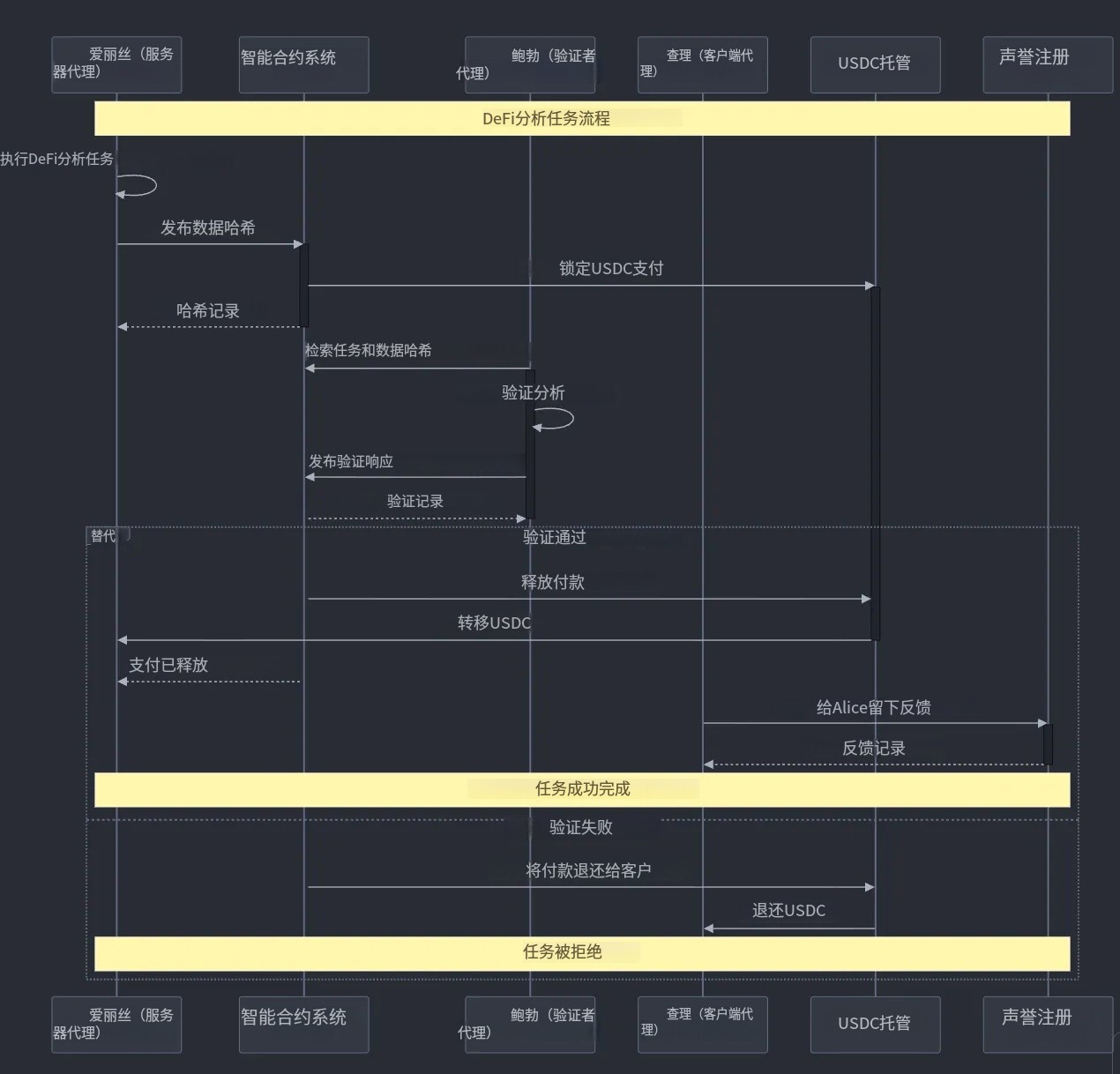
(Source: Researcher Yehia Tarek personal column)
The entire process requires no human intervention; three AI Agents autonomously complete a commercial transaction based on the trust system of ERC-8004.
Wait, how is this related to x402?
To clarify the relationship between x402 and ERC-8004 in one sentence:
x402 solves the payment issue for AI Agents, while ERC-8004 solves the trust issue, and both are indispensable for a truly autonomous AI economy.
Specifically, x402 is a standard for micropayments between agents or users, eliminating payment friction; it allows one agent to automatically pay another agent for completing a task.
ERC-8004 is the identity and reputation layer for agents. It introduces on-chain verification, making each task and score traceable.
A more understandable analogy is:
x402 = ERC20
ERC 8004 = Etherscan
The former allows you to pay API access fees directly based on the number of calls, more like a payment standard; the latter is more like an on-chain AI agent registry, where each agent has an associated wallet that is verifiable.
In fact, all of this is part of a larger narrative of "crypto x AI." Under a broad crypto AI economy:
- Crypto AI Economy = Discover AI Agents + AI Agents can communicate with each other + Verifiable computation
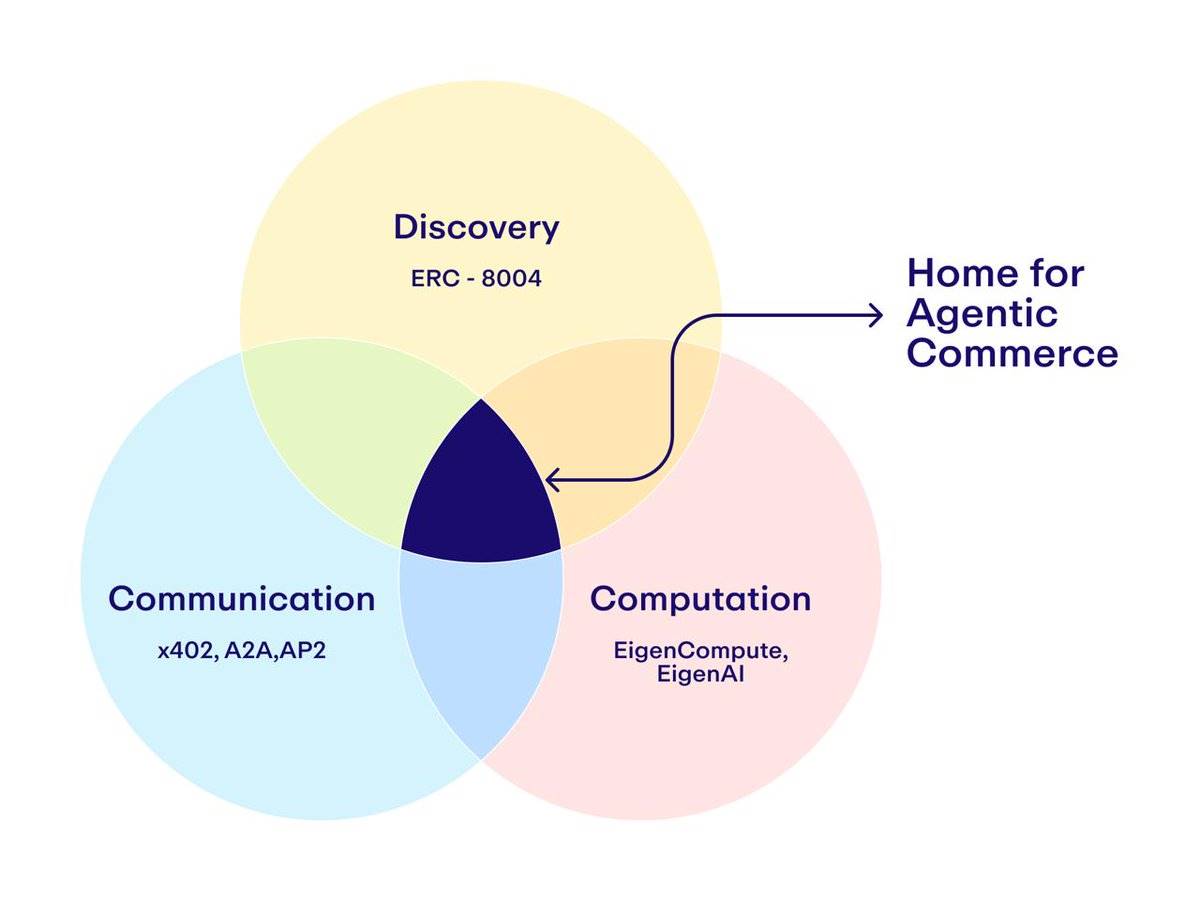
How to discover AI Agents? Essentially, it is about enabling AI Agents to find each other, which is what ERC-8004 does by writing a registry on Ethereum to record the identities of the AIs.
How to enable communication between AI Agents? x402 is an open standard for agents to make on-chain payments; additionally, there are Google's A2A protocol and others.
How to verify all of this? Each AI Agent must perform verifiable reasoning, inference, and actions, which may be recorded in places that emphasize data availability.
Twitter user @soubhik_deb has a post worth reading, which clearly explains the above logic and can help discover more Alpha project opportunities based on this logic.
(Image source: Twitter user @soubhik_deb)
At this point, we have fully understood the relationship between x402 and ERC-8004. Describing their relationship in terms of complementarity and jointly building the overall AI economy is more appropriate.
If you want a clearer and more explicit comparison, here is a visual representation:
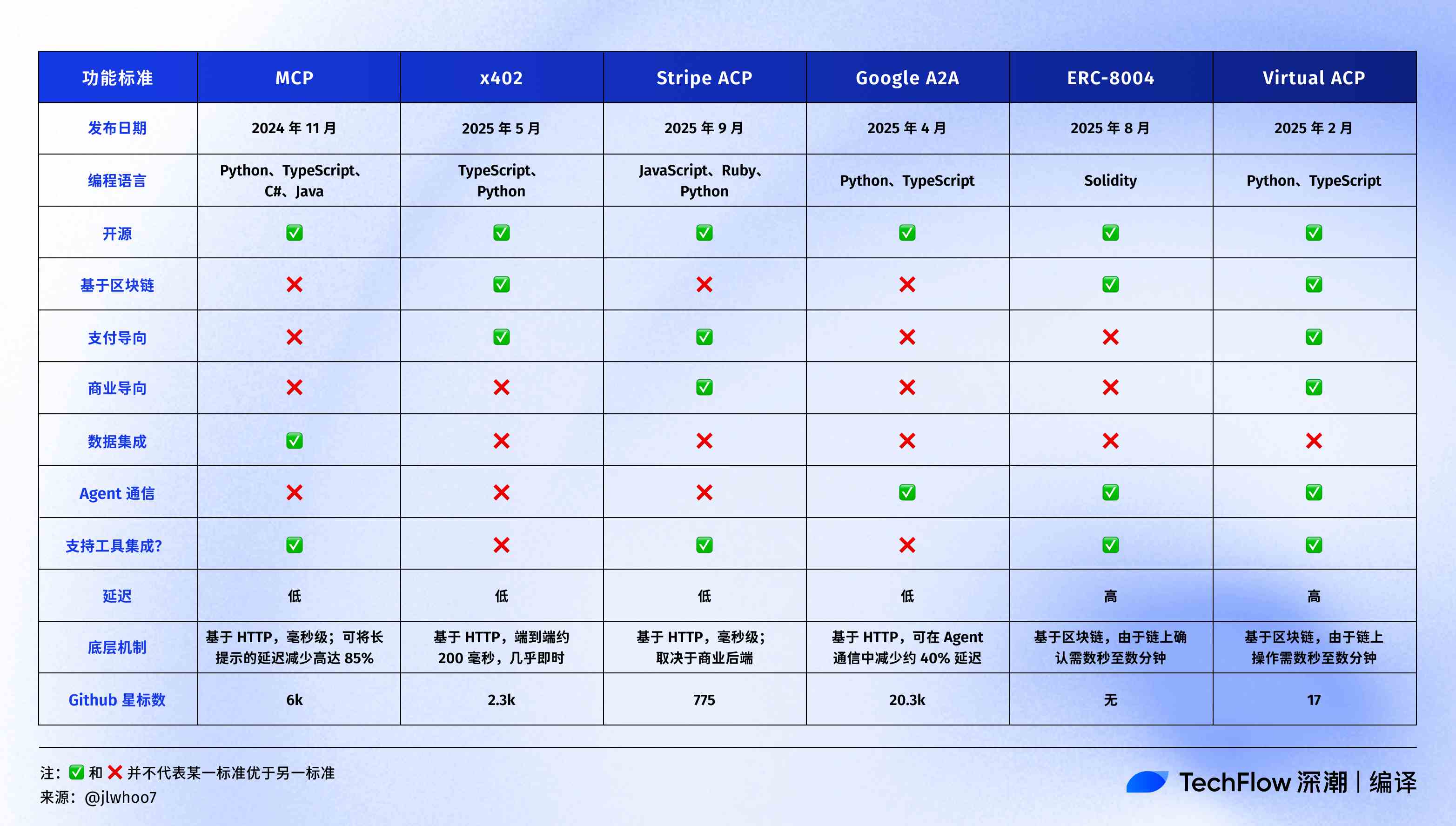
Beneficial Projects under the ERC-8004 Narrative
For a quick overview, you can refer directly to the image below.
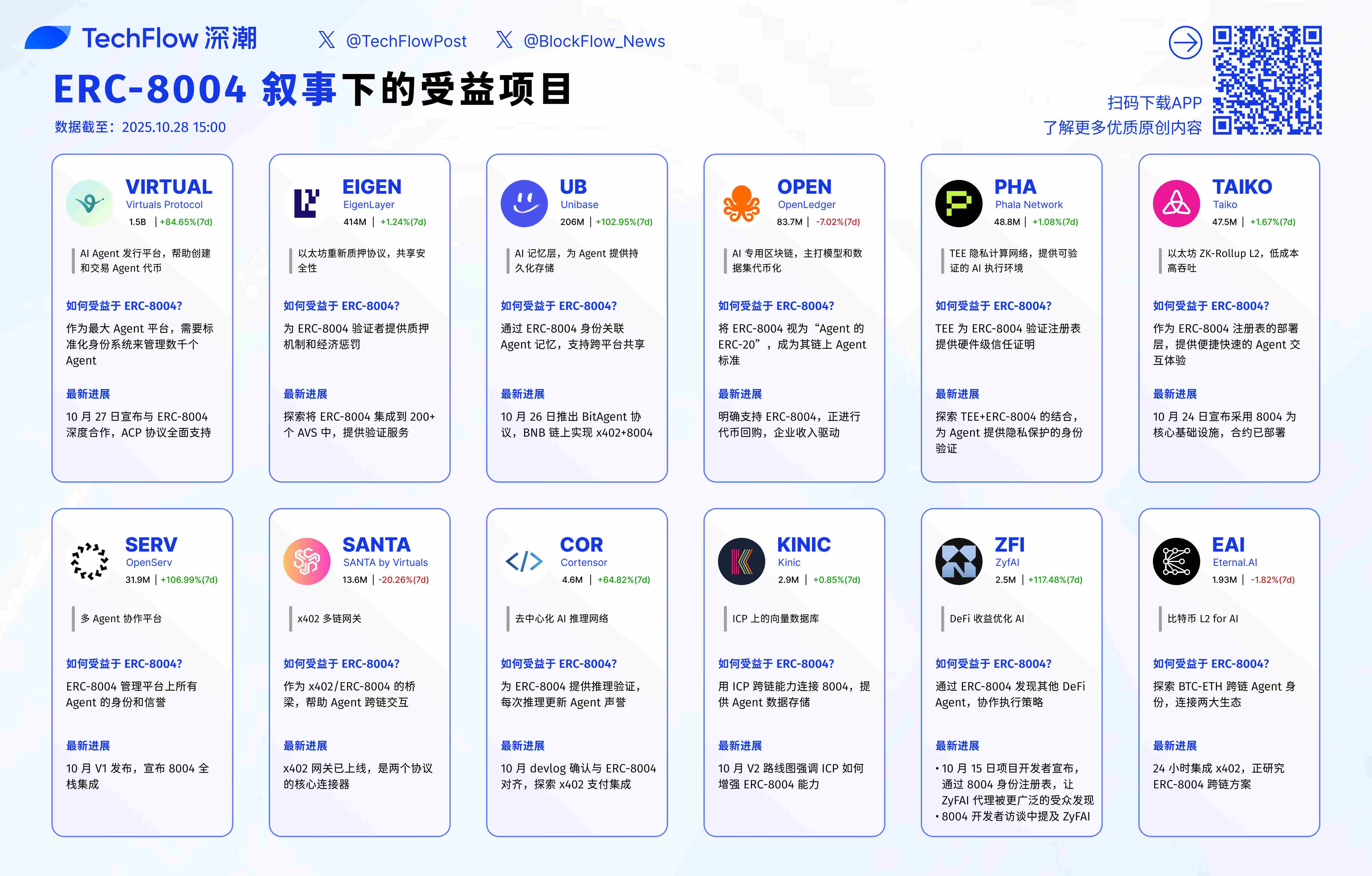
When x402 exploded, the first tokens to rise were payment tokens like PING. However, the opportunities presented by ERC-8004 are more widespread, with each layer having its own logic from infrastructure to applications. Understanding this logic is more important than chasing individual projects.
- First is the infrastructure layer, such as Taiko and EigenLayer.
Taiko, L2 Execution Layer
Why would an L2 be the most active supporter? The narrative here is that the agent economy needs cheap and fast chains. The mainnet is too expensive, with gas fees of several dollars for each identity or reputation update, which agents cannot afford. Taiko provides a solution by deploying the 8004 registry on L2, reducing costs. As of October 24, the contract has been deployed and may become the main battleground for agent activities.
EigenLayer, Security Layer
The biggest challenge for 8004 is what to do if validators act maliciously. EigenLayer's answer is: staking penalties. Validators stake ETH, and if they provide false verification, their assets are forfeited. EigenLayer is integrating 8004 into over 200 AVS, each of which could become a dedicated agent verification service.
The logic of infrastructure is simple: the more agents there are, the more transactions occur, and the more revenue is generated. This is a shovel-selling business.
- Next is the middleware layer, such as S.A.N.T.A and Unibase.
S.A.N.T.A, Payment Bridge
Its positioning straddles two narratives, acting as a connector between x402 and 8004. When one agent finds another through 8004 and then needs to pay via x402, S.A.N.T.A handles this process. More importantly, it facilitates cross-chain interactions; for example, under the ideal narrative, if a Solana agent wants to hire an Ethereum agent, S.A.N.T.A can play a role.
Unibase, Memory Layer
Agents not only need identities but also memory. Unibase provides each agent with persistent storage linked through the 8004 identity system. This means agents can "remember" previous interactions, accumulate experience, and even share knowledge. As of October 26, x402 + 8004 integration has been implemented on the BNB chain, leading the way.
The value of middleware lies in its irreplaceability. You can switch L2s, but certain connection functionalities are unique.
- Finally, the application layer, such as the familiar Virtuals Protocol.
Virtuals is a platform for issuing AI Agent tokens, allowing users to create, invest in, and trade AI Agent tokens through a bonding curve mechanism.
Currently, there are over 1,000 agent projects on the platform, with daily trading volumes exceeding 20 million dollars.
For Virtuals, 8004 addresses a practical issue: how to enable different agents to recognize and interact with each other. Recently, its official Twitter account indicated that the ACP protocol update will fully support the 8004 standard, meaning that every agent issued on Virtuals will automatically gain an on-chain identity and reputation system.
As for which applications will emerge, they may combine with Launchpad mechanics, further observing updates in rule design and incentives.
Overall, x402 addresses the payment issue, while ERC-8004 addresses the trust issue. x402 took 5 months from release to explosion, and 8004 may be even faster.
On the timeline, you can pay attention to the Devconnect on November 21, which will feature a Trustless Agents Day showcase. The first applications based on 8004 may demonstrate their functionalities at the conference. If a killer application emerges, it could trigger the first wave of speculation.
By the end of this year, I predict that x402 ecosystem projects will enter a consolidation phase and are likely to announce support for 8004. The interaction between the two protocols will produce a 1+1>2 effect.
For conservative players, it may be wise to focus on large-cap infrastructure projects benefiting from 8004; for more aggressive players, closely monitoring the small-cap projects in the above table and new projects emerging is essential.
After all, the crypto market has not been dominated by a technology-driven narrative for a long time. Whether this time's x402 and ERC-8004 are fleeting or have far-reaching impacts will be left for the market to test.
免责声明:本文章仅代表作者个人观点,不代表本平台的立场和观点。本文章仅供信息分享,不构成对任何人的任何投资建议。用户与作者之间的任何争议,与本平台无关。如网页中刊载的文章或图片涉及侵权,请提供相关的权利证明和身份证明发送邮件到support@aicoin.com,本平台相关工作人员将会进行核查。


